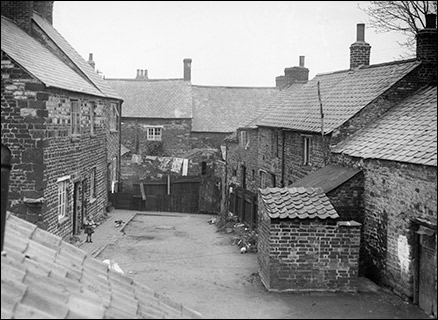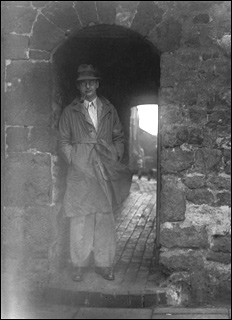Article taken from an Evening Telegraph Special Agricultural supplement 24 May 1935 |
||||
|
||||
|
||||
|
Clearance Scheme Opposed at Burton Latimer
Mr Borman described the alleged defects of the houses in detail, and said the site density was about 24 per acre, whereas the maximum allowed by the Ministry was 12 per acre. The Clerk: Are you aware that the owners have put in reconditionary proposals? – Yes, but I am prepared to say that this property cannot be reconditioned. Total and absolute demolition is the only satisfactory remedy. LOW RENTALS Cross-examining by Mr W A Kirby (of Messrs Berry Bros and Bagshaw, Kettering), who appeared for the owners, Mr Borman said it would not be costly to put in water and sewage. The owners had not actually refused to carry out repairs. The rents included 6s., 6s.4d., 4s. Mr Kirby: Have you in Burton similar accommodation that you can let at these rents? – No. Dr J M Mackntosh, the County Medical Officer, said that in 1933 he visited about 4,300 houses in the county to obtain an idea of the general conditions of the working-class tenants in Northamptonshire and to compare that with other counties. He tried to adopt the attitude, especially with regard to old stone-built houses, that he should like to save them if they could be saved. With regard to the Burton property he came to the conclusion that it should not be preserved, and that if it were reconditioned precisely the same essential defects would occur. Dr Mackintosh described the condition of the houses in detail and said that in one there was a pantry 6ft.6 ins., by 3ft. in which there was a copper and stove as well as food. INSPECTOR WARNED Referring to another house he said to the Inspector: “I should advise you when you visit this house to take care when going up the stairs, because the room opening from them is so small and inconvenient that the bar of the bed hangs over the stairs so that you get a terrific knock as you go up. The bed in fact fills more than the room” Dr A P Kingsley, the Urban Council’s medical officer, said the conditions in the houses were unhygienic and not conducive to the health or happiness of the inhabitants. Mr W A Kirby, on behalf of Miss Talbutt said she was of small independent means and she objected to the proposals, as she was seriously concerned at the prospect of her income being diminished. In addition the cottages were in mortgage with other cottages, and if demolition took place a particularly heavy burden would fall on the remainder, and there was a possibility that the mortgage might be called in. “People are very chary of lending money on this sort of property,” Mr Kirby added. “and it may be that the whole lot will be forced into the market with serious loss to Miss Talbutt. “After all the owner of property is entitled to just as much consideration as the tenants. We have heard that there are features detrimental to health. But the tenants can go. We have not asked them to stay. Mr Kirby added that they also objected to the demolition because they considered that the property was capable of being re-conditioned. EXCELLENT WALLS Mr H R Surridge, architect, of Kettering, said he considered that the walls were in excellent condition, and the roofs compared very favourably with that type of property. Mr Kirby: Having regard to the soundness of the structure are you of the opinion that this property can be reconditioned? – Yes. It is proposed to knock Nos.150 and 152 into one house and Nos.138, 140 and 142 into another. Mr Surridge added that the sanitary arrangements would be made satisfactory as each house would be provided with a water closet and a sink and general defects would be made good. Cross-examined by Mr Harvey, Mr Surridge said that where there was damp, steps would be taken to remove it. He had had no instructions to put in a bath. Questioned by Mr Kirby, he said it was not usual to find bathrooms in houses let at 4s. or 5s. per week. Mr Kirby said Mr Surridge had been given instructions that the re-conditioning was to be at a reasonable cost. Miss Talbutt said she was prepared to spend from £120 to £130 on the reconditioning. Cross-examined by Mr Harvey, Miss Talbutt said she had always tried to carry out repairs asked for. PRAISEWORTHY OFFER In view of the re-conditioning proposals Mr Harvey recalled the Surveyor and County Medical Officer. Mr Borman said there would still be lack of space and air. Dr Mackintosh said that the proposals were the most praiseworthy and best attempts he had seen for dealing with such a difficulty, but he was afraid that they did not meet the essential case. “I still feel that the attempt at reconditioning would not solve the problem.” Dealing with Nos. 122, 124 and 126, of which Mr W Cooper is the executor, Mr Kirby said he took exception to remarks of the County Medical Officer, but he was prepared to recondition them at a cost of £26. Mr Surridge said the walls and roofs were sound. Two of the houses would be made into one, and the other, which was formerly a small factory, would not be used as a dwelling house. Mr Harvey said the Council still considered they could not be reconditioned on these lines. Mr Kirby said that with the greatest possible respect to the County Medical Officer and Sanitary Inspector, he would point out that they were not architects, and he submitted that in regard to reconditioning the evidence of Mr Surridge should carry the greater weight. He had said that the houses could be reconditioned at a reasonable cost, and if bathrooms were absolutely necessary they could be put in. IN SUNSHINE Mr Cooper said the houses were in sunshine for practically the whole of the day. It seemed impossible to conceive that there should be demolition if the houses could be made habitable. He was anxious to meet the requirements of the Council.
Click here for another article relating to these properties |
||||

